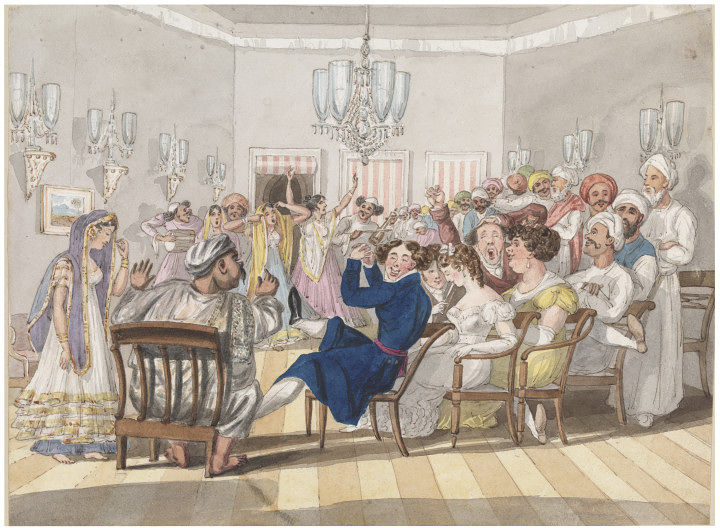INTRO
This rosewood chair with cane seat was produced in India or the East Indies in the early 19th century.
When the Europeans came to India, they were in need of furniture as the natives traditionally sat on the ground. So they exported their own furniture for the native carpenters as a prototype for them to copy. The natives put in some of their own taste into the furniture which led to the emergence of the Indo-European style.
There are three groups: Portuguese, Dutch, or British.
After some reading I feel that the rosewood chair may fit into the Portuguese group.
INDO PORTUGUESE STYLE
This style consists of two styles: the Northern Indian style or the Mughal and Southern style aka Goanese.
The Northern Indian Style: Involves furniture decorated with inlaid bone, ivory on ebony and other dark woods. Resembles tables and writing cabinets from the Italian Renaissance – a dominant style in Portugal at that time
The Goanese Style: Many pieces are made of rosewood (the main reason why I believe the chair comes from this style). Distinguished by small and elegant pieces, flowery design and a holy cross relating to Christian influence of the Portuguese.
I still feel iffy since the chair does not have flowery design or a cross. I think what makes this chair unique is its arm rest loop.
DAY TO DAY
Early 16th century adventurers had little need for sophisticated chairs. Any decorative chairs they brought with them were for ceremonial use and were used as thrones. They were inlaid with precious gold or silver. This shows that this rosewood chair was not used as a ceremonial chair. It might have been a more day to day chair.
What makes it a more day to day chair is this: below, the chair is depicted in a painting by Charles D’Oyly in Patna in 1825-28.
Nop Kishen’s Nautch Party
Watercolour illustration showing a nautch party at which Europeans cavort on chairs, with dancing girls in the background. The assorted chairs depicted include one with the back-looped arms later associated with the courts of the Sikhs.
 Source: Victoria and Albert Museum, London
Source: Victoria and Albert Museum, London
The Rice Table, 1883 -1889.
This European family is served a rice table by their servants in Batavia. Note the chair on the left. We do not know for sure if this is the raffles chair or the loop rosewood chair.

Source: Tropenmusuem: 3728-820
UNKNOWN ORIGINS OF THE LOOP
In Amin Jaffer’s book, Furniture from British India and Ceylon, there is a similar chair with back-looped arms made out of ivory. The loop has been thought to be a common feature to colonial chairs in British India and the East Indies. However, another example of a pair of English looped chairs in the 19th century has been found that predates all Indian examples. Whether it was the English or Indian chair-makers who came up with the loop is hard to know. However, the loop, for certain, is popular in British India and East Indies in the early 19th century.

Ivory Chair, India, 1810, The Henry P. McIlhenny Collection in memory of Frances P. McIlhenny, 1986
Source: Philadelphia Museum of Art
Hardwood chairs with hoped arms were widely used among Europeans in the east.
THE CANE SEAT
Early versions of ebony chairs with seats of woven cane were the first examples to reach Europe. Caning was initially introduced to the East Indies by Chinese traders (suitable hard woods there and good for mass production). Rattan remained popular in the East till 19th century and is a characteristic of the dutch colonial chairs.
A SIMILAR CHAIR – RAFFLES ARMCHAIR

Mr and Mrs Richmond Thackeray and their son, William Makepeace Thackeray, 1814. George Chinnery
Source: Artfinder
This chair looks almost the same except there are no loops. The arm supports and the cane seating and back are distinctively colonial. These chairs were also very popular in the East Indies and throughout India in the early 19th century. In the Dutch East Indies, they were known as Rafflesstoelen meaning Raffles Chairs. They were named after Sir Stamford Raffles, founder of Singapore and Governor of Java.
Sources:
De Dampierre, Florence. Chairs, A History. Harry N. Abrams; First Edition edition, 2006.
“Roots.sg.” Www.roots.sg. 2014. Accessed October 10, 2018. https://roots.sg/.
“The Past Perfect Collection.” www.pastperfect.sg. Accessed October 24, 2018. https://www.pastperfect.sg/.
Jaffer, Amin, Karina Corrigan, Robin D. Jones, Mike Kitcatt, Markham Sexton, and Jeffrey Dykes. Furniture from British India and Ceylon: A Catalogue of the Collections in the Victoria and Albert Museum and the Peabody Essex Museum. Salem, MA: Peabody Essex Museum, 2001.
Gompel, Dave van, Joost Hoving, Reinier Klusener. Furniture from the Netherlands East Indies 1600-1900: A Historical Perspective Based on the Collection of the Tropenmusuem.


 Source: Victoria and Albert Museum, London
Source: Victoria and Albert Museum, London 















